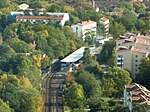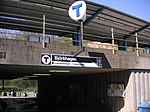Sickla kanalbro

Sickla kanalbro (Swedish: "Sickla Canal Bridge") is a bridge in central Stockholm, Sweden. Stretching over Sickla kanal ("Canal of Sickla"), it connects Södra Hammarbyhamnen to Nacka. The name Sickla is believed to be derived from a 15th-century provincial word, sik, meaning "minor marsh".A product of post-WW2 traffic loads, the bridge was built 1954-1955 as a continuous steel girder bridge resting on four supports and carrying a concrete roadway. 60 metres long and 10,3 metres wide, the bridge passes over three spans with a maximum span of 23 metres and an average horizontal clearance over the canal of 4,6 metres. The supports are built on a foundation of concrete poles, while the abutments are resting directly on the bedrock. The bridge was originally built with a future widening in mind, something which had to wait until 1979 when a 2,6 metres wide cantilevering pathway was added on the south side of the roadway.
Excerpt from the Wikipedia article Sickla kanalbro (License: CC BY-SA 3.0, Authors, Images).Sickla kanalbro
Sickla Kanalbro, Stockholm Södra Hammarbyhamnen (Södermalms stadsdelsområde)
Geographical coordinates (GPS) Address Nearby Places Show on map
Geographical coordinates (GPS)
| Latitude | Longitude |
|---|---|
| N 59.30229 ° | E 18.1103 ° |
Address
Sickla Kanalbro
Sickla Kanalbro
120 68 Stockholm, Södra Hammarbyhamnen (Södermalms stadsdelsområde)
Sweden
Open on Google Maps











